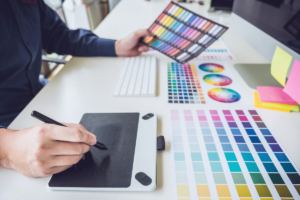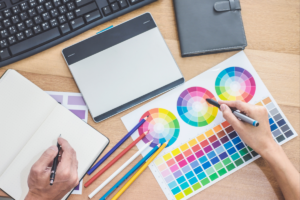There’s a whole world of psychology behind why certain visuals work better than others. When it comes to branding, the choices of colors and design elements can impact your audience’s perception. Beyond picking your favorite colors or following design trends, the psychology behind color and design can actually influence how people perceive and interact with your brand. Let’s look into color psychology and design elements in branding to understand why certain visuals resonate more than others.
The Power of Color in Branding
Colors sure are pretty to look at, and they’re also powerful communicators. Color can evoke emotions, trigger memories, and yes, influence behavior. Here’s a quick rundown of how different colors are typically perceived in branding:
Red: Excitement, passion, urgency Think about brands like Coca-Cola or Netflix. Red grabs attention and creates a sense of excitement.
Orange: Friendliness, confidence, adventure Companies like Nickelodeon and Fanta use orange to appeal to a youthful, energetic audience.
Yellow: Optimism, clarity, warmth McDonald’s golden arches are a perfect example of using yellow to create a cheerful, welcoming vibe.
Green: Growth, health, nature Whole Foods and Animal Planet use green to reinforce their connection to nature and wellness.
Blue: Trust, stability, calmness Think Facebook, LinkedIn, or IBM. Blue is often used by tech and financial companies to convey reliability.
Purple: Luxury, creativity, mystery Brands like Cadbury and Hallmark use purple to convey a sense of indulgence or imagination.
Black: Sophistication, power, elegance Think of luxury brands like Chanel or tech giants like Apple. Black conveys a sense of premium quality.
White: Purity, simplicity, cleanliness Apple also uses a lot of white, as do many healthcare brands, to convey a sense of clarity and cleanliness.
But the thing is, these associations aren’t universal. Cultural differences also impact color perception. For instance, while white represents purity in many Western cultures, it’s associated with mourning in some Eastern cultures. Always consider your target audience’s cultural background when choosing your brand colors.

Color Combinations
How you combine colors can make or break your brand’s visual appeal. Here are a few classic combinations:
Monochromatic: Using different shades of the same color. This creates a cohesive, sophisticated look.
Analogous: Using colors that are next to each other on the color wheel. This creates a harmonious, pleasing aesthetic.
Complementary: Using colors opposite each other on the color wheel. This creates a vibrant, eye-catching contrast.
Triadic: Using three colors equally spaced on the color wheel. This creates a balanced yet vibrant look.
The key is to find a combination that not only looks good but also aligns with your brand’s personality and values.
Beyond Color
While color plays an important role, it’s just one piece of the puzzle. Other design elements can improve how your brand is perceived:
Shapes: Different shapes evoke different emotions and associations.
- Circles: Unity, completeness, harmony
- Squares/Rectangles: Stability, trust, order
- Triangles: Power, science, law
- Organic shapes: Comfort, positivity, nature
Fonts: Your choice of typography can say a lot about your brand.
- Serif fonts (like Times New Roman): Traditional, respectable, reliable
- Sans-serif fonts (like Arial): Modern, clean, straightforward
- Script fonts: Elegant, creative, personal
- Display fonts: Unique, expressive, attention-grabbing
Imagery: The types of images you use in your branding also play a role.
- Photos vs. illustrations
- Realistic vs. abstract
- People vs. objects
- Close-ups vs. wide shots
Each choice sends a message about your brand’s personality and values.
Putting It All Together
Now that we’ve broken down the elements, let’s talk about how to bring them all together into a cohesive brand identity.
Start with Your Brand’s Personality
Before you even think about colors or fonts, get clear on your brand’s personality. Are you playful or serious? Luxurious or down-to-earth? Innovative or traditional? Your visual identity should be an extension of this personality.
Consider Your Industry… Then Decide Whether to Fit In or Stand Out
Look at the common color schemes and design elements in your industry. Do you want to align with these conventions to build trust, or break away from them to stand out? There’s no right answer – it depends on your brand strategy.
Think About Your Target Audience
Who are you trying to reach? A color scheme that appeals to retirees might not resonate with Gen Z unless your making New Balance sneakers. Consider the age, gender, cultural background, and preferences of your target audience.
Test Different Combinations
Don’t be afraid to experiment. Create mood boards with different color combinations, font pairings, and design elements. Get feedback from your team and, if possible, from members of your target audience.
Make it Versatile
Your brand colors and design elements need to work across all mediums – from your website to your business cards to your product packaging. Make sure your choices translate well to both digital and print formats.
Create a Style Guide
Once you’ve settled on your visual identity, document it in a comprehensive style guide. This helps keep things consistent across all brand touchpoints.
The Evolving World of Brand Design
It’s worth noting that brand design isn’t static. As culture evolves, so do color associations and design trends. What worked five years ago might feel outdated today. That’s why it’s important to periodically review and refresh your brand’s visual identity.
However, be cautious about chasing trends. A complete overhaul of your visual identity can confuse your audience and dilute brand recognition. Instead, look for ways to evolve your brand design while maintaining your core visual elements.

Wrapping Up
Choosing your brand’s colors and design elements is both an art and a science. It requires a deep understanding of color psychology and design principles, combined with intuition and creativity. Remember, there’s no one-size-fits-all solution. What works for one brand might fall flat for another. Always align your visual identity with your brand’s personality, values, and target audience.
At Bay Laurel, we love helping businesses find their unique visual voice. Whether you’re starting from scratch or looking to refresh your existing brand, we’re here to help you create a visual identity that not only looks great but also resonates deeply with your audience.
After all, in a world where first impressions are often visual, your brand’s colors and design could be the difference between a scroll-past and a loyal customer. Choose wisely!
Try Brandforma
To take your branding to the next level, consider our Brandforma program. Brandforma helps you find clarity, direction, and a meticulously built roadmap to reach your brand’s fullest potential. We begin with a mind-opening call featuring specific questions designed to spark strategic breakthroughs. Included with Brandforma is a comprehensive guide for launching, scaling, and attracting higher-value leads.
You can implement this action plan on your own or hire us to handle it with our Brandflip services. Let’s collaborate and make your brand the best it can be!



